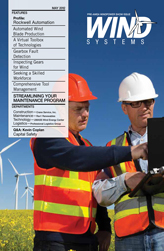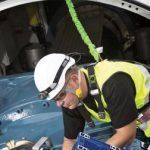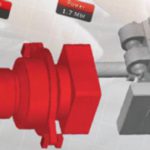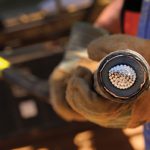Traditional design and verification procedures in developing a new product or improving upon existing technology can be time consuming, costly, and in some cases physically impractical or risky in the field. Typically, many disciplines will be involved in the iteration loop from concept to product launch and the number of prototype and test iterations can become staggering. The application of advanced computer simulation techniques—“virtual simulation” or “virtual testing”—can help shorten the process (and enable verification and evaluation of designs at an early stage when all options are open), reduce a need for prototyping, troubleshoot for root causes when components fail and, ultimately, optimize a system’s overall performance and reliability.
Challenge: A major wind turbine manufacturer was in the process of designing a large turbine with an objective to sustain a 20-year lifecycle. The design team additionally sought documentation that the mainshaft bearing and housing arrangement would fulfill requirements of international certification bodies active in the wind industry.
Solution: Enlisting extensive experience in bearing system structural fatigue analysis and applying proprietary virtual simulation technology with the capability to evaluate the dynamic behavior of rolling bearings, SKF engineering consultants conducted a highly accurate analysis of the turbine housing, including bearing and mainframe interaction. Detailed results enabled engineers to assess the design from a system fatigue perspective and generate valuable input for future design improvements without the need to develop a prototype (or wait for 20 years to ascertain actual lifecycle performance of the turbine). Figure 1
Results: Analysis confirmed the main bearing housing design would meet extreme load and fatigue-load conditions and that the design would not lead to premature bearing failure over the required 20-year service life. Supporting documentation was compiled to apply for formal international certification of the design.
Simulating Dynamic Behavior
Rolling element bearings are a bridge between rotating and static parts and often are a key element for the behavior of the complete application. They consist of an inner ring, outer ring, and a set of rolling elements (balls or rollers). Most rolling bearings also have a cage (or cages) and a few types feature a guide ring. Most commercial simulation tools offer a bearing “representation,” usually sidelining the cage or describing in simplified models.
The dynamic phenomena that occur in rolling bearings require specialized simulation tools for evaluation. SKF has been developing simulation tools to analyze bearing and bearing systems for more than 40 years. The first tools focused on an accurate representation of a bearing by itself and were greatly limited by the computational power available.
Today’s tools allow for the accurate representation of not only the bearing, but of the complete system such as a gearbox. The SKF tool, called BEAST (for Bearing Simulation Tool), simulates the behavior of complete bearing, including cages, using a fully three-dimensional, specialized tribological contact model (which also accounts for the effects of small-scale geometric variations, such as surface roughness).
This simulation program additionally builds upon or otherwise augments commercial CADS/FEA/CFD systems enabling importing and exporting of system information that may or may not be required for an accurate description of the bearing dynamics. SKF BEAST utilizes fully transient models (generating results over a time domain), compensating for flexibility in bearing geometry (for accurate bearing load calculations), and accommodating all bearing types to develop accurate and detailed bearing models (with geometry based on exact manufacturing data).
Unleashing the BEAST
BEAST is based on multi-body techniques and with special focus on contact problems. It allows for studies of dynamic behavior of all bearing components to be carried out under general loading conditions. This includes the forces on (and motions of) the cage, skew, and tilt behavior of rollers and the skidding of balls.
Principal output data from BEAST relates to the movements of all bearing components, the contact forces between the components, and the forces with the environment. Additionally, detailed data from the contacts are produced (for example, power loss, lubricant film thickness, pressure distribution, slip-speed distribution, and wear). Figure 2
The output data can be studied in several ways. Animation of bearing components can serve as a good visual starting point (and motions can be magnified for more clarity). Force or velocity vectors can be added to the animation. Some parameters, such as contact pressure or slip velocities, can be displayed as three-dimensional images on the bodies or on parametric surfaces. All output data can be reviewed in more detail using graphical formats.
The integration of Design for Six Sigma (DfSS) into the modeling process introduces a framework for optimized evaluation of selected bearing arrangements. Utilizing the DfSS process enables a structured approach and toolbox to identify critical to performance operating parameters.
The performance of bearings will be influenced by many different system design and operating parameters. Some can be controlled during operation, while others cannot but may have a significant impact on system performance. One example of combining virtual simulation and DfSS is to generate a virtual design of experiments (DoE). Through a statistical analysis of DoE results, the robustness of a bearing system can be ascertained along with the influences that design parameters exert on performance. Figure 3
In a design of experiments, different calculation runs will be made to rank the parameters in terms of their influence on the bearing’s performance. The model allows many more parameters to be analyzed independently compared with physical assembly and testing. This type of analysis can help optimize system settings to increase robustness and reduce performance variability.
Such models can help designers narrow their choices and evaluate the various options early in the design process or beyond. Designers can strategically factor in different parameters and tolerances to understand how they will impact overall performance without use of a prototype or physical testing. As a particular example, friction and thermal models can provide an accurate temperature prediction that can help in determining bearing life and clearance, lubrication intervals and conditions, and proper lubricant selection, among other purposes.
Final Note
While virtual simulation and testing cannot necessarily replace all physical testing and prototyping, technologies offer a practical methodology to investigate parameters and test conditions too difficult to achieve otherwise. Along the way, the number of iterations on the road to a viable design can be reduced significantly. In the near future, advances in computers and simulation technology can be expected to increase capabilities and provide designers with even keener insights into how bearings and systems can (and should) perform.








































